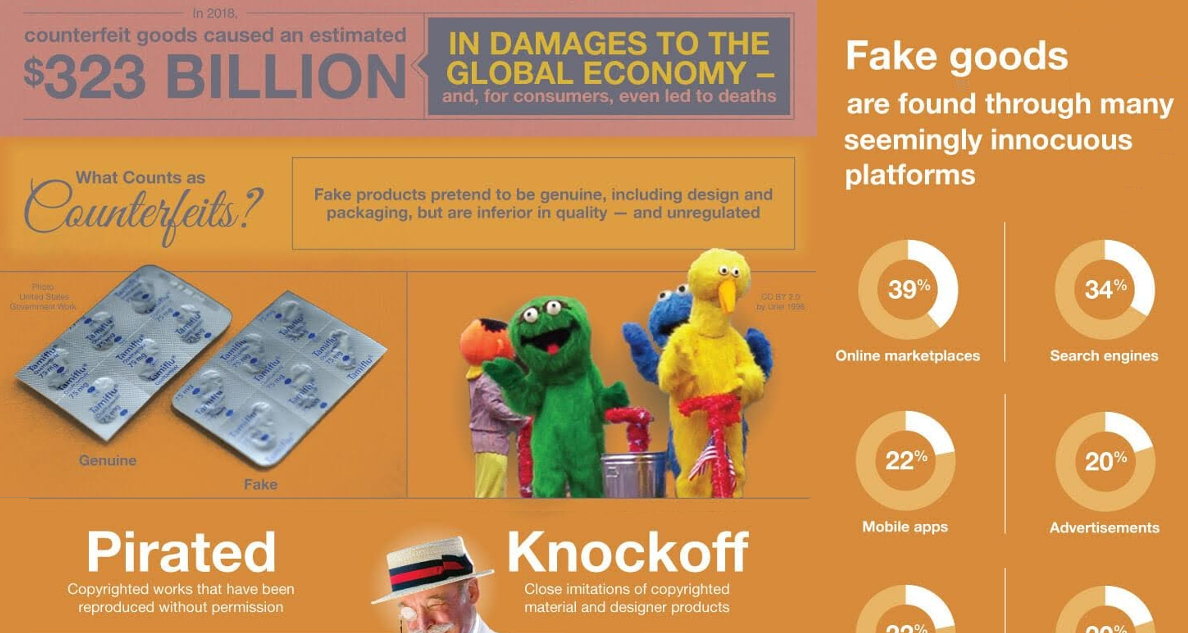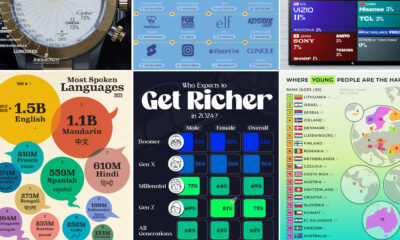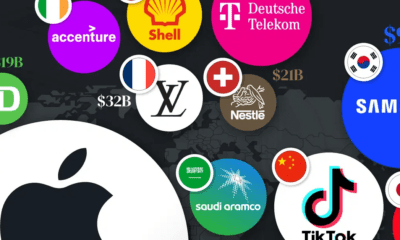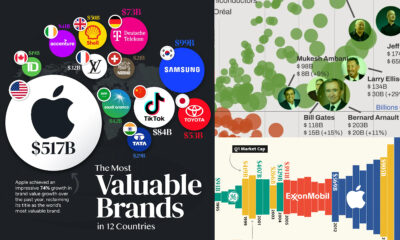Markets
The $300 Billion Counterfeit Goods Problem, and How It Hurts Brands
When you are walking along the boardwalk on vacation, you know it’s a “buyer beware” type of situation when you buy directly from a street vendor.
Those Cuban cigars are probably not Cubans, the Louis Vuitton bag is a cheap replica, and the Versace sunglasses too cheap to be the real thing.
But what if you placed an order for something you thought was truly legitimate, and the fake brand had you fooled? What if this imitation product fell apart in a week, short-circuited, or even caused you direct harm?
Can you Spot a Fake?
Today’s infographic comes to us from Best Choice Reviews, and it highlights facts and figures around counterfeit goods that are passed off as quality brands, and how this type of activity damages consumers, businesses, and the wider economy.

In 2018, counterfeit goods caused roughly $323 billion of damage to the global economy.
These fake products, which pretend to by genuine by using similar design and packaging elements, are not only damaging to the reputations of real brands – they also lead to massive issues for consumers, including the possibility of injury or death.
A Surprisingly Widespread Issue
While it’s easy to downplay the issue of fake goods, it turns out that the data is pretty clear on the subject – and counterfeit goods are finding their way into consumer hands in all sorts of ways.
More than 25% of consumers have unwillingly purchased non-genuine goods online – and according to a test by the U.S. Government Accountability Office, it was found that two of every five brand name products they bought online (through 3rd party retailers) were counterfeits.
Some of the most common knockoff goods were as follows:
- Makeup – 32%
- Skincare – 25%
- Supplements – 22%
- Medication – 16%
- Economic Impact
On a macro scale, the sale of counterfeit goods can snowball into other issues. For example, U.S. accusations of Chinese manufacturers for stealing and reproducing intellectual property has been a major driver of tariff action. - Unsecure Information
Counterfeit merchants present higher risks for credit card fraud or identity theft, while illegal download sites can host malware that steals personal information - Criminal Activity
Funds from illicit goods can also be used to help bankroll other illegal activities, such as extortion or terrorism. - Unsafe Problems
It was found that 99% of all fake iPhone chargers failed to pass critical safety tests – and 10% of medical products are counterfeits in developing countries, which can raise the risk of illness or even death.
Aside from the direct impact on consumers and brands themselves, why does this matter?
The Importance of Spotting Fakes
Outside of the obvious implications, counterfeit activity can open up the door to bigger challenges as well.
The issue of fake goods is not only surprisingly widespread in the online era, but the imitation of legitimate brands can also be a catalyst for more serious problems.
As a consumer, there are several things you can do to increase the confidence in your purchases, and it all adds up to make a difference.
Economy
Economic Growth Forecasts for G7 and BRICS Countries in 2024
The IMF has released its economic growth forecasts for 2024. How do the G7 and BRICS countries compare?

G7 & BRICS Real GDP Growth Forecasts for 2024
The International Monetary Fund’s (IMF) has released its real gross domestic product (GDP) growth forecasts for 2024, and while global growth is projected to stay steady at 3.2%, various major nations are seeing declining forecasts.
This chart visualizes the 2024 real GDP growth forecasts using data from the IMF’s 2024 World Economic Outlook for G7 and BRICS member nations along with Saudi Arabia, which is still considering an invitation to join the bloc.
Get the Key Insights of the IMF’s World Economic Outlook
Want a visual breakdown of the insights from the IMF’s 2024 World Economic Outlook report?
This visual is part of a special dispatch of the key takeaways exclusively for VC+ members.
Get the full dispatch of charts by signing up to VC+.
Mixed Economic Growth Prospects for Major Nations in 2024
Economic growth projections by the IMF for major nations are mixed, with the majority of G7 and BRICS countries forecasted to have slower growth in 2024 compared to 2023.
Only three BRICS-invited or member countries, Saudi Arabia, the UAE, and South Africa, have higher projected real GDP growth rates in 2024 than last year.
| Group | Country | Real GDP Growth (2023) | Real GDP Growth (2024P) |
|---|---|---|---|
| G7 | 🇺🇸 U.S. | 2.5% | 2.7% |
| G7 | 🇨🇦 Canada | 1.1% | 1.2% |
| G7 | 🇯🇵 Japan | 1.9% | 0.9% |
| G7 | 🇫🇷 France | 0.9% | 0.7% |
| G7 | 🇮🇹 Italy | 0.9% | 0.7% |
| G7 | 🇬🇧 UK | 0.1% | 0.5% |
| G7 | 🇩🇪 Germany | -0.3% | 0.2% |
| BRICS | 🇮🇳 India | 7.8% | 6.8% |
| BRICS | 🇨🇳 China | 5.2% | 4.6% |
| BRICS | 🇦🇪 UAE | 3.4% | 3.5% |
| BRICS | 🇮🇷 Iran | 4.7% | 3.3% |
| BRICS | 🇷🇺 Russia | 3.6% | 3.2% |
| BRICS | 🇪🇬 Egypt | 3.8% | 3.0% |
| BRICS-invited | 🇸🇦 Saudi Arabia | -0.8% | 2.6% |
| BRICS | 🇧🇷 Brazil | 2.9% | 2.2% |
| BRICS | 🇿🇦 South Africa | 0.6% | 0.9% |
| BRICS | 🇪🇹 Ethiopia | 7.2% | 6.2% |
| 🌍 World | 3.2% | 3.2% |
China and India are forecasted to maintain relatively high growth rates in 2024 at 4.6% and 6.8% respectively, but compared to the previous year, China is growing 0.6 percentage points slower while India is an entire percentage point slower.
On the other hand, four G7 nations are set to grow faster than last year, which includes Germany making its comeback from its negative real GDP growth of -0.3% in 2023.
Faster Growth for BRICS than G7 Nations
Despite mostly lower growth forecasts in 2024 compared to 2023, BRICS nations still have a significantly higher average growth forecast at 3.6% compared to the G7 average of 1%.
While the G7 countries’ combined GDP is around $15 trillion greater than the BRICS nations, with continued higher growth rates and the potential to add more members, BRICS looks likely to overtake the G7 in economic size within two decades.
BRICS Expansion Stutters Before October 2024 Summit
BRICS’ recent expansion has stuttered slightly, as Argentina’s newly-elected president Javier Milei declined its invitation and Saudi Arabia clarified that the country is still considering its invitation and has not joined BRICS yet.
Even with these initial growing pains, South Africa’s Foreign Minister Naledi Pandor told reporters in February that 34 different countries have submitted applications to join the growing BRICS bloc.
Any changes to the group are likely to be announced leading up to or at the 2024 BRICS summit which takes place October 22-24 in Kazan, Russia.
Get the Full Analysis of the IMF’s Outlook on VC+
This visual is part of an exclusive special dispatch for VC+ members which breaks down the key takeaways from the IMF’s 2024 World Economic Outlook.
For the full set of charts and analysis, sign up for VC+.
-

 Markets1 week ago
Markets1 week agoU.S. Debt Interest Payments Reach $1 Trillion
-

 Business2 weeks ago
Business2 weeks agoCharted: Big Four Market Share by S&P 500 Audits
-

 Real Estate2 weeks ago
Real Estate2 weeks agoRanked: The Most Valuable Housing Markets in America
-

 Money2 weeks ago
Money2 weeks agoWhich States Have the Highest Minimum Wage in America?
-

 AI2 weeks ago
AI2 weeks agoRanked: Semiconductor Companies by Industry Revenue Share
-

 Markets2 weeks ago
Markets2 weeks agoRanked: The World’s Top Flight Routes, by Revenue
-

 Demographics2 weeks ago
Demographics2 weeks agoPopulation Projections: The World’s 6 Largest Countries in 2075
-

 Markets2 weeks ago
Markets2 weeks agoThe Top 10 States by Real GDP Growth in 2023















